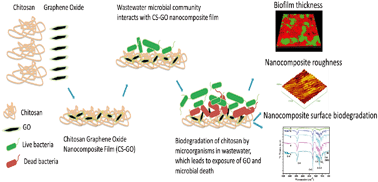当前位置:
X-MOL 学术
›
Environ. Sci.: Nano
›
论文详情
Our official English website, www.x-mol.net, welcomes your feedback! (Note: you will need to create a separate account there.)
Biodegradation of graphene oxide-polymer nanocomposite films in wastewater
Environmental Science: Nano ( IF 7.3 ) Pub Date : 2017-07-20 00:00:00 , DOI: 10.1039/c7en00396j Jingjing Fan 1, 2, 3, 4 , Carlos David Grande 5, 6, 7, 8 , Debora F. Rodrigues 1, 2, 3, 4
Environmental Science: Nano ( IF 7.3 ) Pub Date : 2017-07-20 00:00:00 , DOI: 10.1039/c7en00396j Jingjing Fan 1, 2, 3, 4 , Carlos David Grande 5, 6, 7, 8 , Debora F. Rodrigues 1, 2, 3, 4
Affiliation

|
The synthesis of polymer nanocomposites has been extensively investigated by many researchers, however, the end of life fate of polymer nanocomposites is still largely unknown. It is expected that at the end of their service life, these polymer nanocomposites will most likely end up in soil and water systems where microorganisms will interact and, perhaps, even biodegrade them. In this study, we investigate the ability of wastewater microorganisms to biodegrade nanocomposite films containing different graphene oxide (GO) loads (0% to 0.6%, (w/w%)) embedded in a model biopolymer (i.e. chitosan). The ability of wastewater microorganisms to grow and form biofilms on the surface of the nanocomposite films was determined by live and dead staining assisted with confocal laser scanning microscopy. The capability of wastewater biofilms to biodegrade nanocomposites was assessed through nanocomposite film weight losses, Fourier transformed infrared (FTIR) and scanning electron microscopy (SEM) analyses. Results showed that microorganisms present in the activated sludge can grow on the surface of the nanocomposites and biodegrade the polymer surrounding the graphene oxide nanoplatelets. As the biopolymer gets degraded, there is increasing exposure of GO on the surface, which yields microbial inactivation and biofilm growth inhibition. To determine the evolution of the toxicity of the nanocomposite during biodegradation. We determined the emergence of the sharp edges of GO on the surface of the nanocomposite through atomic force microscopy (AFM), as well as the production of reactive oxygen species (ROS) with the Ellman's assay before and after biodegradation of the nanocomposites. The results show that as GO surfaces the nanocomposite film during biodegradation, there is increasing production of ROS, which explains the increasing inactivation of the microorganisms.
中文翻译:

废水中氧化石墨烯-聚合物纳米复合薄膜的生物降解
聚合物纳米复合材料的合成已被许多研究者广泛研究,但是,聚合物纳米复合材料的寿命终了仍是未知数。预计在使用寿命结束时,这些聚合物纳米复合材料很可能最终会在土壤和水系统中最终与微生物发生相互作用,甚至可能对其进行生物降解。在这项研究中,我们调查废水的微生物的生物降解含有不同的氧化石墨烯的纳米复合材料薄膜的能力(GO)的负载(0%〜0.6%,(重量/重量%))嵌入在模型生物聚合物(即壳聚糖)。通过共聚焦激光扫描显微镜辅助的活着和死去染色来确定废水微生物在纳米复合膜表面上生长和形成生物膜的能力。通过纳米复合材料薄膜的重量损失,傅立叶变换红外(FTIR)和扫描电子显微镜(SEM)分析评估了废水生物膜生物降解纳米复合材料的能力。结果表明,存在于活性污泥中的微生物可以在纳米复合材料的表面上生长,并且可以生物降解氧化石墨烯纳米片周围的聚合物。随着生物聚合物降解,表面上GO的暴露量增加,这会导致微生物失活和生物膜生长受到抑制。确定生物降解过程中纳米复合材料毒性的演变。我们通过原子力显微镜(AFM)确定了GO尖锐边缘在纳米复合材料表面上的出现,以及在纳米复合材料生物降解之前和之后通过Ellman法测定了活性氧种类(ROS)的产生。结果表明,随着GO在生物降解过程中使纳米复合膜表面化,ROS的产量增加,这说明了微生物的灭活作用增加。
更新日期:2017-09-14
中文翻译:

废水中氧化石墨烯-聚合物纳米复合薄膜的生物降解
聚合物纳米复合材料的合成已被许多研究者广泛研究,但是,聚合物纳米复合材料的寿命终了仍是未知数。预计在使用寿命结束时,这些聚合物纳米复合材料很可能最终会在土壤和水系统中最终与微生物发生相互作用,甚至可能对其进行生物降解。在这项研究中,我们调查废水的微生物的生物降解含有不同的氧化石墨烯的纳米复合材料薄膜的能力(GO)的负载(0%〜0.6%,(重量/重量%))嵌入在模型生物聚合物(即壳聚糖)。通过共聚焦激光扫描显微镜辅助的活着和死去染色来确定废水微生物在纳米复合膜表面上生长和形成生物膜的能力。通过纳米复合材料薄膜的重量损失,傅立叶变换红外(FTIR)和扫描电子显微镜(SEM)分析评估了废水生物膜生物降解纳米复合材料的能力。结果表明,存在于活性污泥中的微生物可以在纳米复合材料的表面上生长,并且可以生物降解氧化石墨烯纳米片周围的聚合物。随着生物聚合物降解,表面上GO的暴露量增加,这会导致微生物失活和生物膜生长受到抑制。确定生物降解过程中纳米复合材料毒性的演变。我们通过原子力显微镜(AFM)确定了GO尖锐边缘在纳米复合材料表面上的出现,以及在纳米复合材料生物降解之前和之后通过Ellman法测定了活性氧种类(ROS)的产生。结果表明,随着GO在生物降解过程中使纳米复合膜表面化,ROS的产量增加,这说明了微生物的灭活作用增加。



























 京公网安备 11010802027423号
京公网安备 11010802027423号